![U.S. F-Class Open Team Shiraz Balolia]()
This August the U.S. National and World F-Class Championships will be held in Raton, New Mexico. The U.S. F-Class Open Team has been working hard to prepare for the Worlds in Raton. This will be the fourth F-Class World Championship and first time it is being held in the USA. Team Captain Shiraz Balolia and his team-mates hope to successfully defend “home turf” this summer. The F-Class World Championships will run August 23 to 27, 2013. Preceding the World Championships, the U.S. F-Class National Championships will be held from August 18 to 22, 2013.
Team Members and Selection Process
![U.S. F-Class Open Team Shiraz Balolia]() The US F-Class Open Rifle Team consists of the top F-Open shooters in the United States. Some members were on previous teams, but Team Captain Shiraz Balolia explains: “Our try-out process was very stringent and above board, which removed the notion of an ‘old boys club’ and allowed a lot of new blood to try out for the team”.
The US F-Class Open Rifle Team consists of the top F-Open shooters in the United States. Some members were on previous teams, but Team Captain Shiraz Balolia explains: “Our try-out process was very stringent and above board, which removed the notion of an ‘old boys club’ and allowed a lot of new blood to try out for the team”.
The selection process was straightforward. Each participant had to have placed in the top 20 of a National Championship or in the top 3 of a regional championship to be able to try out. After that, they had to participate in at least three try-outs over a two-year period. There were about a dozen try-outs at various venues (Houston, Lodi, Raton, Phoenix, Sacramento) which allowed shooters from all over the country to participate. Shooting during all try-outs were conducted at 1000 yards.
The scoring system was based on “Vertical” Score where the goal of the shooter was to hold good vertical elevation with regards to the X-Ring. All try-outs were shot with coaches and the wind calls were the responsibility of the coach. The shooters were not penalized for wide shots if they were on the waterline. The targets had horizontal lines drawn on them and points were deducted for high and low shots.
![U.S. F-Class Open Team Shiraz Balolia]()
The targets were photographed and published for the try-out participants to view so everyone knew exactly where they stood. Shiraz notes: “This actually worked really well to raise the overall standard of the team as it increased competitiveness among the shooters”.
![U.S. F-Class Open Team Shiraz Bilolia]()
From the initial group, the first cut was made to select the Development Team (DT). These DT shooters then continued further try-outs in 2012 with a similar process. The DT group was then culled to the final team members listed below.
| Captain: Shiraz Balolia; Head Coach: Bob Mead; Other Coaches: Trudie Fay, Rick Hunt, Emil Praslick |
Shooters (alpha sort)
1. Charles Ballard
2. Danny Biggs
3. David Gosnell
4. David Mann
5. Dean Morris
6. Don Nagel
7. Emil Kovan
8. Herb Edwards
9. Jim Murphy
|
10. John Dunbar
11. John Gaines
12. John Myers
13. Ken Dickerman
14. Kenny Adams
15. Larry Bartholome
16. Mark Walker
17. Rick Jensen
18. Robert Bock
19. Tony Robertson |
F-Class Insights: Q&A with Team Captain Shiraz Balolia
We did a Q&A session with Shiraz Balolia, F-Open Team Captain. Shiraz offered candid answers to “hot topic” questions of interest to F-Class shooters. He also observed that his team is working very, very hard in preparation for the World Championships. After being beaten by the Brits in 2009, Shiraz says: “We have a score to settle….”
![U.S. F-Class Open Team Shiraz Balolia]()
Q: The F-Open Team has switched calibers. What was the thinking behind that move?
Shiraz: After we lost to the Brits in 2009, it became a foregone conclusion that we needed to shoot a 7mm cartridge. Charles Ballard and Jim Murphy were among the first guys in the USA to recognize the virtue of the 7 mm (.284) caliber. The choices we had within the .284 family were: straight .284 Win, .284 Shehane, 7 RSAUM, or 7 WSM variant. After much experimentation and thought we decided on the 7 RSAUM and 7 WSM family of casings which allowed us velocities of around 3000 FPS with a 180gr bullet. With the advent of new 180gr bullets from Berger and Sierra, we were able to get extremely flat-shooting groups (tight vertical) with the velocities that we needed.
Q: Foreign teams won the last two F-Class World Championships. How are you going to beat the Brits and South Africans in 2013?
Shiraz: In the previous World Championship (at Bisley in 2009), the Brits had a huge advantage. Almost all of their shooters lived within a few hours of the Bisley range. The coaches they used knew that range inside out and they were able to practice as a team many times on that range before the World Championships. Plus, they were ahead of us in terms of caliber selection and were shooting 7mm cartridges, as were the South Africans. By contrast, our team came from all over the USA and we had very little time together as a team. Things are different this time… yes, our shooters are still from all over the USA, but the amount of training we have done as a unit, a whole team, is much better than last time around. We have a lot of depth in our team. In other words, our worst shooter is not that far behind our best shooter. I do not believe that there has ever been a long range U.S. Team that has trained this hard and this many times as a unit. We are ready to take on the Brits or any other country!
![U.S. F-Class Open Team Shiraz Balolia]() |
| Shiraz notes: “We did a lot of training on the range as well as in the ‘classroom’ setting with power point presentations. We had numerous sessions like these…. The behind-the-scenes work to deliver ‘same-day’ power-point results (just hours after the scores were shot) provides immediate feedback.” |
Q: How Does Successful Team Shooting Differ from Individual Shooting?
Shiraz: In individual matches, you are responsible for making all the wind calls, corrections on the scope and paying attention to all conditions before taking a shot. Sometimes the condition can change between the time you review the flags and the mirage, make an adjustment and take a shot.
In a team setting, the shooter is responsible for making a really good shot. He/she must be a really good trigger puller who has good equipment, good ammo, and who can follow directions. The coach makes all the calls, he often makes adjustments on your scope and all the shooter has to do is make the shot when asked by the coach. Shooters who second-guess a coach or think they can read the wind better than the coach did not make the team!
Q: Will Team USA Enjoy a ‘Home Court Advantage’ at Raton, NM?
Shiraz: Other than Trudie Fay, one of our coaches, we do not have any team members from the Raton area. We are a very large nation, in size, and our shooters come from all four corners and everywhere in between. Raton is not exactly “home court”, but we have trained there as a team several times. The Brits and the South Africans are no slouches either. The Brits spent a whole week in Raton last year in August to get a feel for the range, the temperature, the wind etc.; the Brits also tested loads for their team members. The South Africans came to shoot against us in September last year at the Stars and Stripes match and also shot at the US F-Class Nationals. The competition is certainly stiff and we can not let our guard down or be over-confident.
Q. Are there special skills and capabilities needed to be a successful team shooter?
Shiraz: To be a really good team member, the shoooter must have all these qualities:
1. He must be able to think in terms of what is best for the team rather than himself.
2. He must have really good equipment. That means a really good barrel, a smooth, trouble-free action, good optics, trigger, rest, etc.
3. He must have superior reloading skills, and be capable of producing really good ammo with bullets that perform consistently shot after shot.
4. He must possess the ability to take direction and put himself at the disposal of the coaches. What we look for in a shooter is consistency over a long period of time, not just a flash in the pan.
The shooters we have on our team have passed all the tests we have put them through and what we have today is, without a doubt, the best United States F-Open Team ever put together.
Support Need for Team Expenses
The U.S. F-Class Open Team may be about $3000.00 short on funds. Any donation will help. Please endorse checks to “US F-Class Open Rifle Team” and mail to P.O. Box 3110, Bellingham, WA 98227.

 The new Competition Scope is a 15-55x52mm. The new scope’s ED (extra-low dispersion) glass yields outstanding resolution. Remarkably, the resolution in the Competition scopes is even slightly better than the Nightforce 12-42x56mm NXS, with its larger 56mm objective lens. The color is definitely ‘crisper’ as well. Not surprisingly, the image quality is what most people noted first (see through-the-lens photo at right). The glass is great, and Nightforce included other thoughtful features as well. First is the side parallax adjustment that competitors have been wanting for years (this is one of the draws for the NXS scope in competition). The higher zoom range (with 55X power on tap), and the 60 MOA of vertical travel is also a much-asked-for (and useful) feature.
The new Competition Scope is a 15-55x52mm. The new scope’s ED (extra-low dispersion) glass yields outstanding resolution. Remarkably, the resolution in the Competition scopes is even slightly better than the Nightforce 12-42x56mm NXS, with its larger 56mm objective lens. The color is definitely ‘crisper’ as well. Not surprisingly, the image quality is what most people noted first (see through-the-lens photo at right). The glass is great, and Nightforce included other thoughtful features as well. First is the side parallax adjustment that competitors have been wanting for years (this is one of the draws for the NXS scope in competition). The higher zoom range (with 55X power on tap), and the 60 MOA of vertical travel is also a much-asked-for (and useful) feature.

 Canadian Fred Harvey of
Canadian Fred Harvey of 










 The offset scope idea came from a benchrest “rail” gun. In truth, the whole concept came from a rail gun — just adapted to being shot off a bipod. Sure it isn’t directly over the bore. It is about 1.5″ over to the left. So if you want the scope to be zeroed on the center of the target, you have to adjust for the offset. At 100 yards that is 1.5 MOA. But at 300 it is only 0.5 MOA, at 600 only a ¼-MOA, and at 1000 about 1 click on my scope.
The offset scope idea came from a benchrest “rail” gun. In truth, the whole concept came from a rail gun — just adapted to being shot off a bipod. Sure it isn’t directly over the bore. It is about 1.5″ over to the left. So if you want the scope to be zeroed on the center of the target, you have to adjust for the offset. At 100 yards that is 1.5 MOA. But at 300 it is only 0.5 MOA, at 600 only a ¼-MOA, and at 1000 about 1 click on my scope.
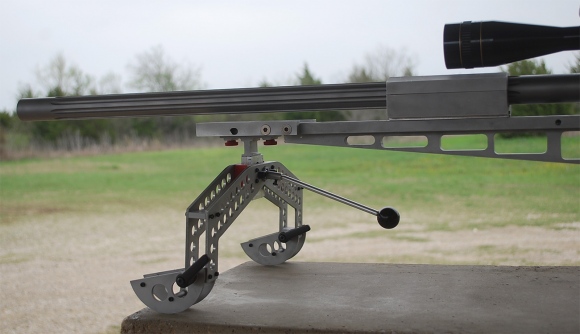
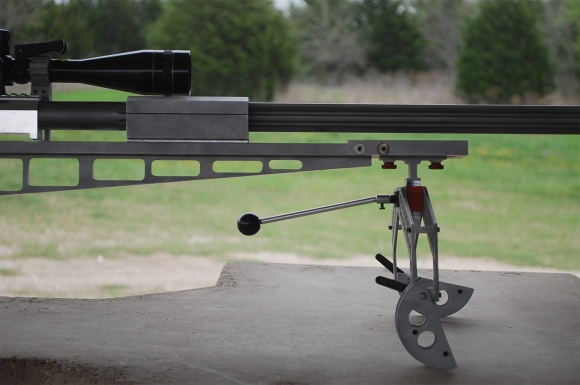

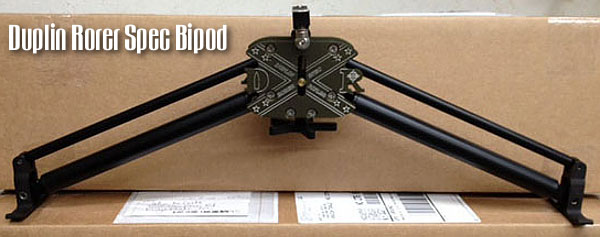


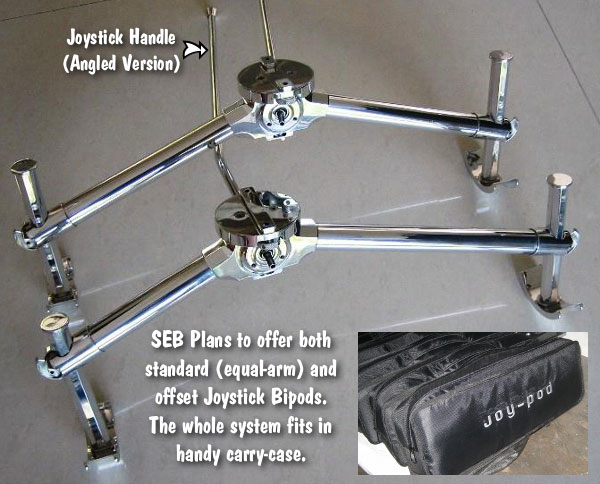








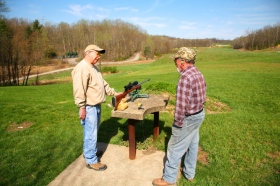
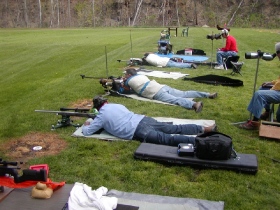

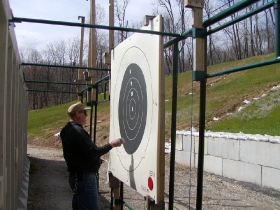





 The Aussies Are Coming!
The Aussies Are Coming!










 Top marksmen from around the world battled for national honors today during Day 1 of the F-Class Team World Championships. F-Open and F-TR teams from many countries were decked out in their national colors. We saw squads from Australia, Brazil, Canada, Great Britain, Ireland, Italy, New Zealand, South Africa, Ukraine, and the USA. Other nations were represented as well.
Top marksmen from around the world battled for national honors today during Day 1 of the F-Class Team World Championships. F-Open and F-TR teams from many countries were decked out in their national colors. We saw squads from Australia, Brazil, Canada, Great Britain, Ireland, Italy, New Zealand, South Africa, Ukraine, and the USA. Other nations were represented as well.
















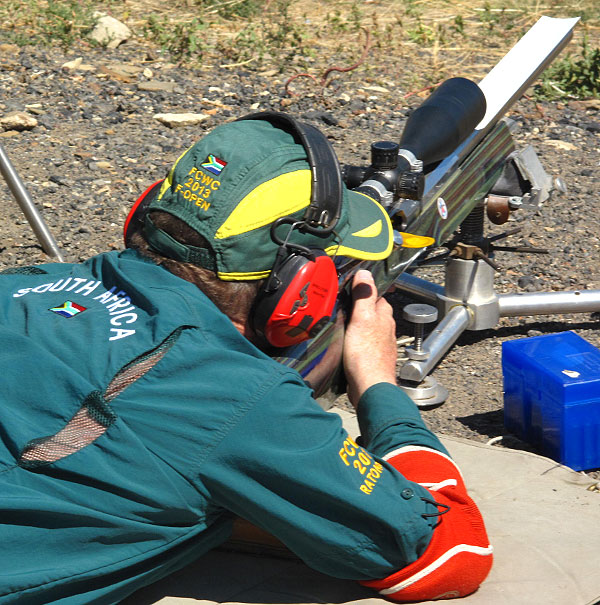

















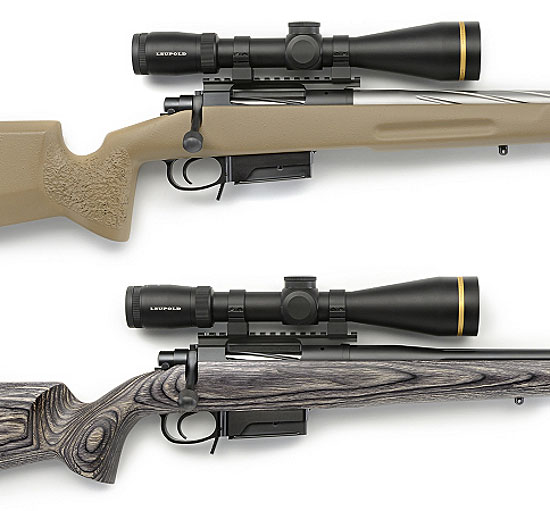
 Many styles of bipods were used by F-TR shooters at the F-Class U.S. Nationals and World Championships recently held in Raton, NM. Most featured angled arms — either left/right arms or parallel pairs of arms on either side. With such designs, vertical height is controlled by adjusting the angle of the arms (and hence the distance between the feet). Widen the track and the gun goes down; narrow the track and the gun goes up. One bipod design, Dan Pohlabel’s
Many styles of bipods were used by F-TR shooters at the F-Class U.S. Nationals and World Championships recently held in Raton, NM. Most featured angled arms — either left/right arms or parallel pairs of arms on either side. With such designs, vertical height is controlled by adjusting the angle of the arms (and hence the distance between the feet). Widen the track and the gun goes down; narrow the track and the gun goes up. One bipod design, Dan Pohlabel’s 




 This rugged, machined-aluminum bipod mount lets you swing your aim point from side to side without having to reposition the bipod. The rubber-padded Upriser Arms Bipod Mount accepts any bipod that attaches to a forward sling swivel stud. There is also a version that fits on tactical rails.
This rugged, machined-aluminum bipod mount lets you swing your aim point from side to side without having to reposition the bipod. The rubber-padded Upriser Arms Bipod Mount accepts any bipod that attaches to a forward sling swivel stud. There is also a version that fits on tactical rails.
